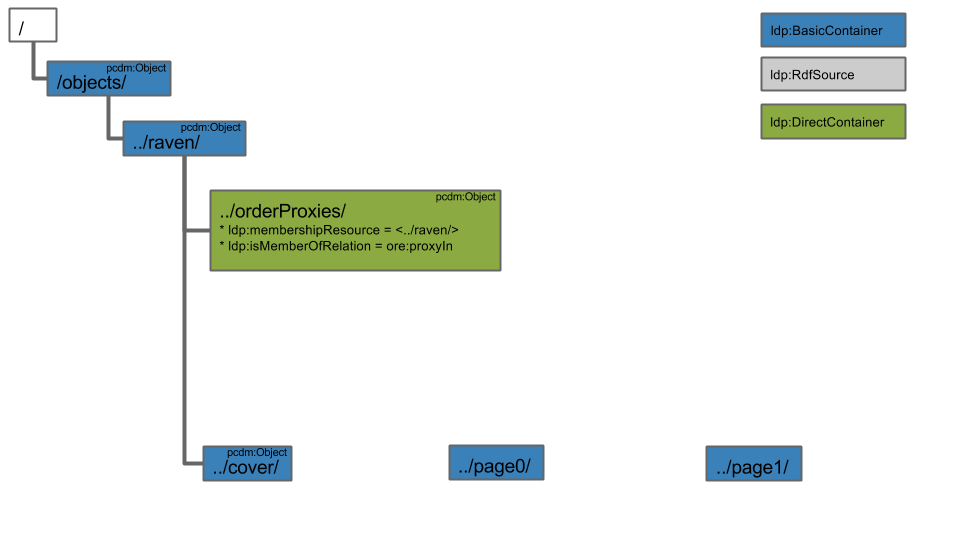- Created by Andrew Woods on Jun 16, 2017
Ordering In Action
This final example will both illustrate a second use of ldp:DirectContainers as well as detail the PCDM recommendation for how to handle ordering of resources.
The addtional predicates/relationships that will be used in this example are:
- ore:proxyIn
- ore:proxyFor
- iana:first
- iana:next
- iana:prev
- iana:last
...all of which are further described in the Portland Common Data Model.

Ordering - Create DirectContainer
As in the book example, begin with creating an ldp:DirectContainer, "orderProxies/", as a child of the book, "raven/", resource. This new DirectContainer will facilitate the auto-creation of triples that will define the membership relationship between the book, "raven/", and the proxies. Then, the new proxy resources within this DirectContainer will be used to establish an ordering of the books pages.
Note: This example assumes the previous creation of "/objects/raven/" and the cover and page resources from the Book example in this series.

curl -i -XPUT -H"Content-Type: text/turtle" --data-binary @ldp-ordering-direct.ttl localhost:8080/fcrepo/rest/objects/raven/orderProxies/
Where "ldp-ordering-direct.ttl" follows:
@prefix ldp: <http://www.w3.org/ns/ldp#> @prefix pcdm: <http://pcdm.org/models#> @prefix ore: <http://www.openarchives.org/ore/terms/> <> a ldp:DirectContainer, pcdm:Object ; ldp:membershipResource </fcrepo/rest/objects/raven/> ; ldp:isMemberOfRelation ore:proxyIn .
An ldp:DirectContaner is an LDP construct that activates the creation of certain RDF triples when a new resource is added as a child of this container.
Like the "pages/" DirectContainer in an earlier example, the "orderProxies/" includes the ldp:membershipResource property ("raven/"). However, it is important to point out that the "orderProxies/" DirectContainer *does not* have the ldp:hasMemberRelation property defined, but instead uses ldp:isMemberOfRelation of "ore:proxyIn".
By using ldp:isMemberOfRelation, the auto-created triple resulting from the addition of a new child resource within "orderProxies/" will take the form:
<new-resource> <ore:proxyIn> <http://localhost:8080/fcrepo/rest/objects/raven/>
We will see this in action next!
Ordering - Create Cover Proxy
Create a new pcdm:Object, "coverProxy/", that is also an ldp:RdfSource within the "orderProxies/" DirectContainer.

curl -i -XPUT -H"Content-Type: text/turtle" --data-binary @ldp-cover-proxy.ttl localhost:8080/fcrepo/rest/objects/raven/orderProxies/coverProxy
Where "ldp-cover-proxy.ttl" follows:
@prefix pcdm: <http://pcdm.org/models#> @prefix ore: <http://www.openarchives.org/ore/terms/> <> a pcdm:Object ; ore:proxyFor </fcrepo/rest/objects/raven/pages/cover> .
As described in the previous step, the addition of "coverProxy" automatically creates the following new triple on "coverProxy"
<http://localhost:8080/fcrepo/rest/objects/raven/orderProxies/coverProxy> ore:proxyIn <http://localhost:8080/fcrepo/rest/objects/raven>
Restating from the previous step,
- the subject of the triple is the new resource ("coverProxy") that was added to the ldp:DirectContainer ("orderProxies/")
- the predicate of the triple comes from the "ldp:isMemberOfRelation" defined on "orderProxies/", and
- the object of the triple comes from the "ldp:membershipResource" defined on "orderProxies/"
Ordering - Create Page0 Proxy
In the same fashion as the previous step, adding "page0Proxy" to the DirectContainer, "orderProxies/" results in a new auto-generated triple on "page0Proxy" of the form:
<http://localhost:8080/fcrepo/rest/objects/raven/orderProxies/page0Proxy> ore:proxyIn <http://localhost:8080/fcrepo/rest/objects/raven>

curl -i -XPUT -H"Content-Type: text/turtle" --data-binary @ldp-page0-proxy.ttl localhost:8080/fcrepo/rest/objects/raven/orderProxies/page0Proxy
Where "ldp-page0-proxy.ttl" follows:
@prefix pcdm: <http://pcdm.org/models#> @prefix ore: <http://www.openarchives.org/ore/terms/> <> a pcdm:Object ; ore:proxyFor </fcrepo/rest/objects/raven/pages/page0/> .
Ordering - Create Page1 Proxy
This step in creating the final page, "page1Proxy", follows the same pattern shown in the previous two steps.

curl -i -XPUT -H"Content-Type: text/turtle" --data-binary @ldp-page1-proxy.ttl localhost:8080/fcrepo/rest/objects/raven/orderProxies/page1Proxy
Where "ldp-page1-proxy.ttl" follows:
@prefix pcdm: <http://pcdm.org/models#> @prefix ore: <http://www.openarchives.org/ore/terms/> <> a pcdm:Object ; ore:proxyFor </fcrepo/rest/objects/raven/pages/page1/> .
Ordering - Create Next and Prev
Now that the proxies have been created, and associated with the book ("raven/") and the proxied resources, we can actually use the proxies to establish ordering, per the PCDM recommendations.
First, establish the order among the proxies with iana:next and iana:prev.

1) Establish "coverProxy" has iana:next of "page0Proxy":
curl -i -XPATCH -H"Content-Type: application/sparql-update" --data-binary @iana-cover-proxy.ru localhost:8080/fcrepo/rest/objects/raven/orderProxies/coverProxy
Where "iana-cover-proxy.ru" follows:
PREFIX iana: <http://www.iana.org/assignments/relation/>
INSERT {
<> iana:next </fcrepo/rest/objects/raven/orderProxies/page0Proxy>
} WHERE {
}
2) Establish both:
- "page0Proxy" has iana:prev of "coverProxy", and
- "page0Proxy" has iana:next of "page1Proxy":
curl -i -XPATCH -H"Content-Type: application/sparql-update" --data-binary @iana-page0-proxy.ru localhost:8080/fcrepo/rest/objects/raven/orderProxies/page0Proxy
Where "iana-page0-proxy.ru" follows:
PREFIX iana: <http://www.iana.org/assignments/relation/>
INSERT {
<> iana:next </fcrepo/rest/objects/raven/orderProxies/page1Proxy> .
<> iana:prev </fcrepo/rest/objects/raven/orderProxies/coverProxy>
} WHERE {
}
3) Establish "page1Proxy" has iana:prev of "page0Proxy":
curl -i -XPATCH -H"Content-Type: application/sparql-update" --data-binary @iana-page1-proxy.ru localhost:8080/fcrepo/rest/objects/raven/orderProxies/page1Proxy
Where "iana-page1-proxy.ru" follows:
PREFIX iana: <http://www.iana.org/assignments/relation/>
INSERT {
<> iana:prev </fcrepo/rest/objects/raven/orderProxies/page0Proxy>
} WHERE {
}
Ordering - Create First and Last
Finally, the very last step is to define from the book's perspective, the iana:first and iana:last pages of "raven/".

Establish both:
- "raven/" has iana:first of "coverProxy", and
- "raven/" has iana:last of "page1Proxy":
curl -i -XPATCH -H"Content-Type: application/sparql-update" --data-binary @iana-raven.ru localhost:8080/fcrepo/rest/objects/raven/
Where "iana-raven.ru" follows:
PREFIX iana: <http://www.iana.org/assignments/relation/>
INSERT {
<> iana:first </fcrepo/rest/objects/raven/orderProxies/coverProxy> .
<> iana:last </fcrepo/rest/objects/raven/orderProxies/page1Proxy>
} WHERE {
}
Ordering - Conclusion
Using LDP in conjunction with PCDM terms, we have established the ordering of pages within the book, "raven/".
- No labels